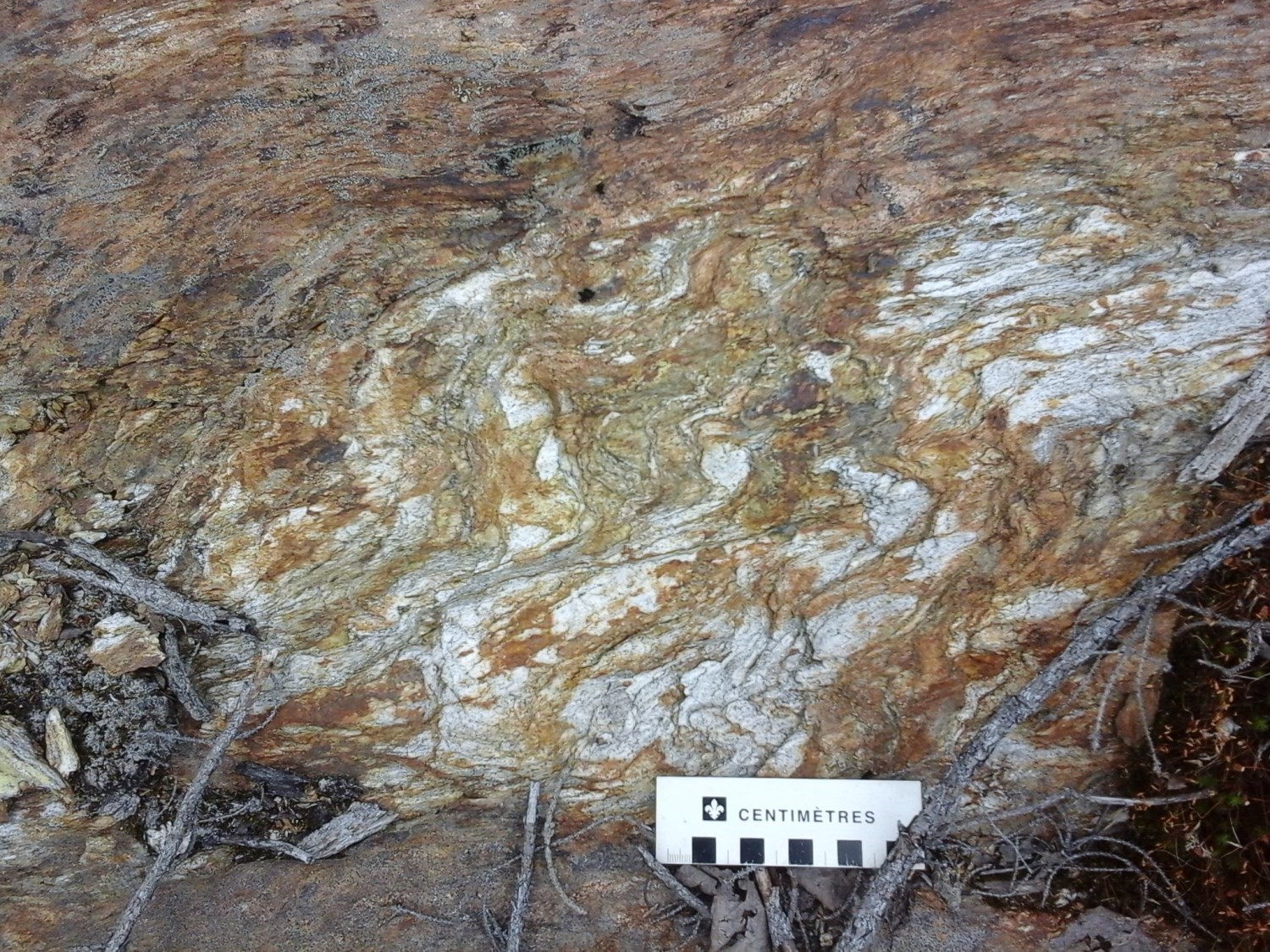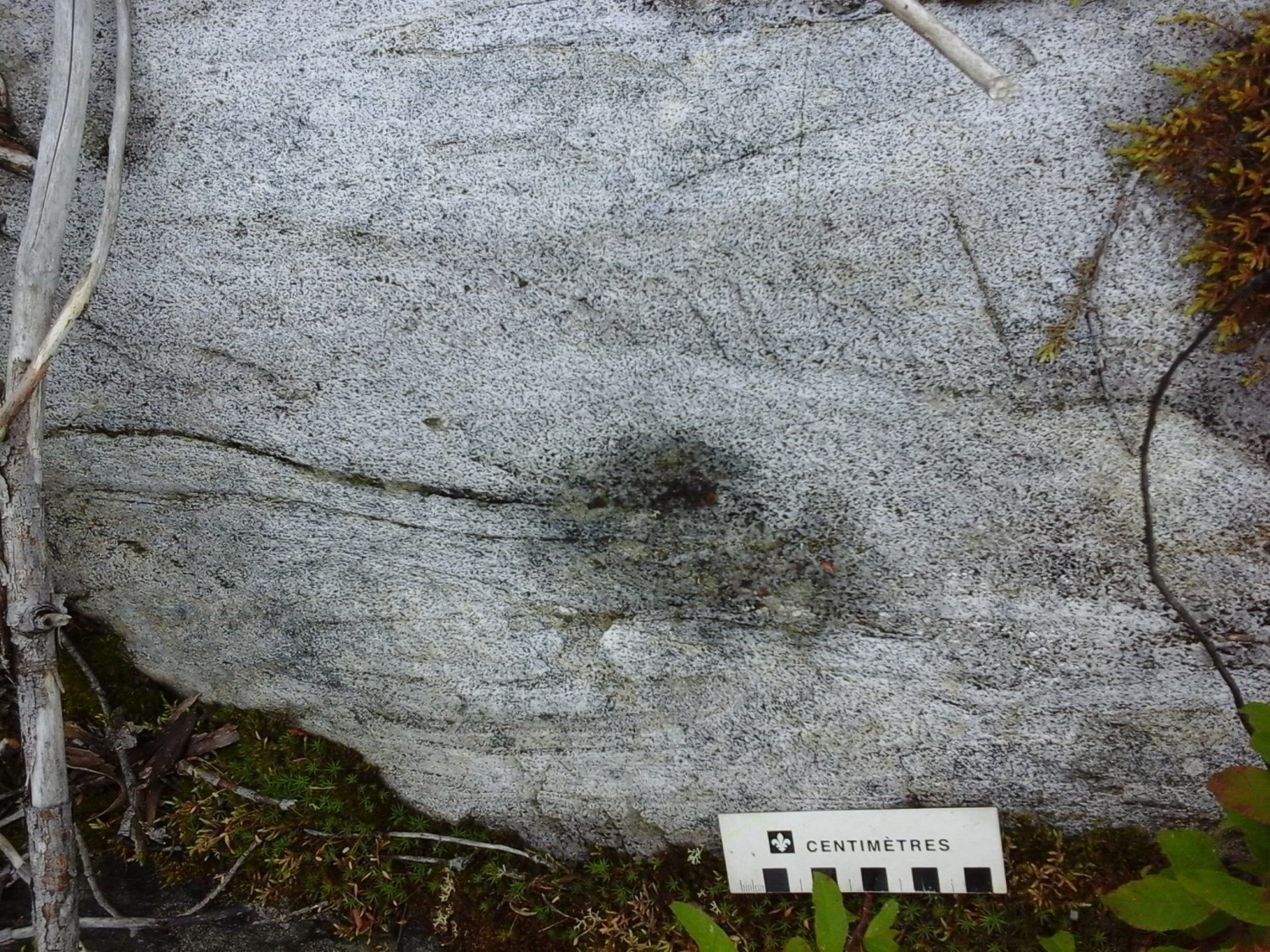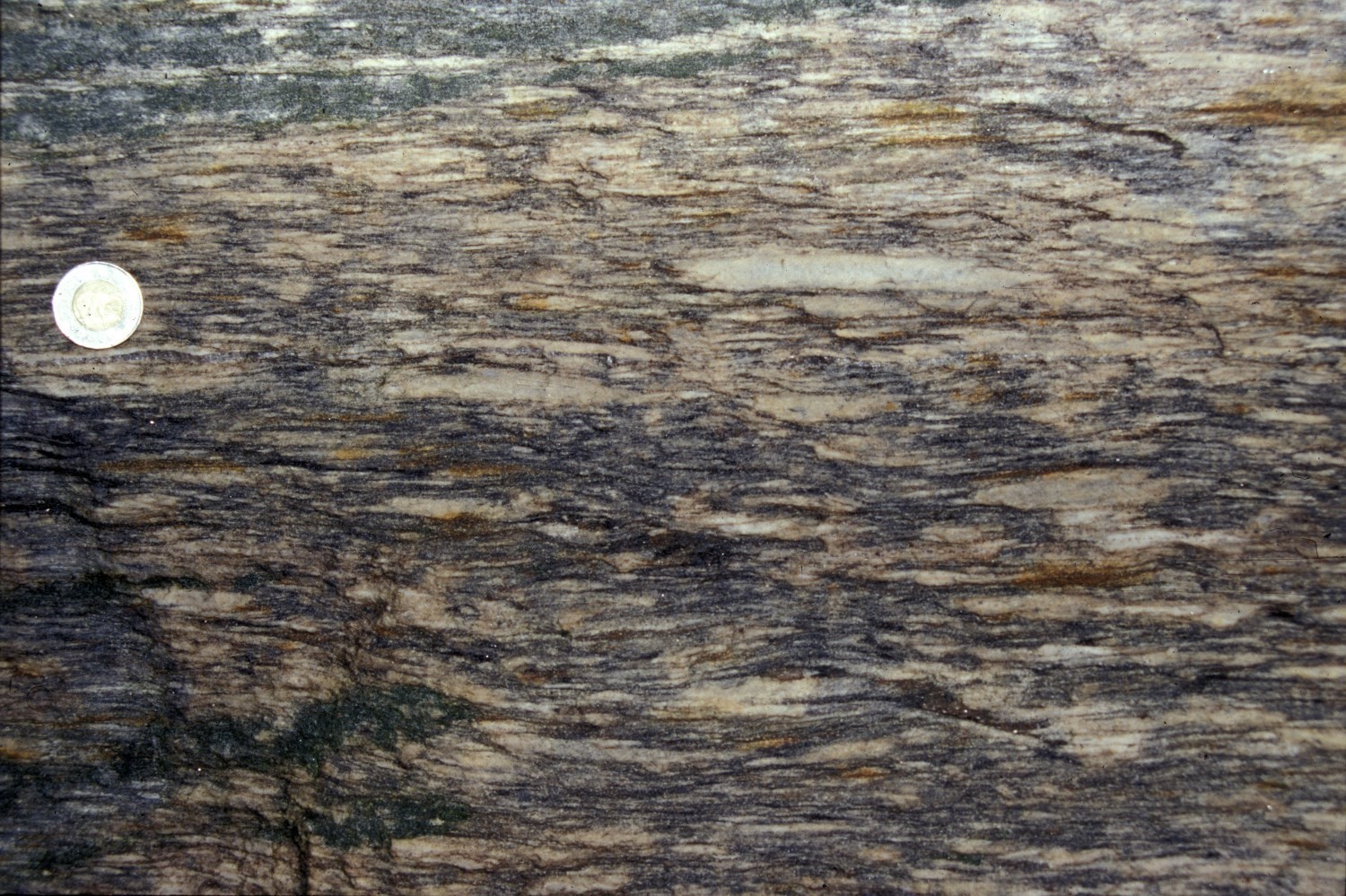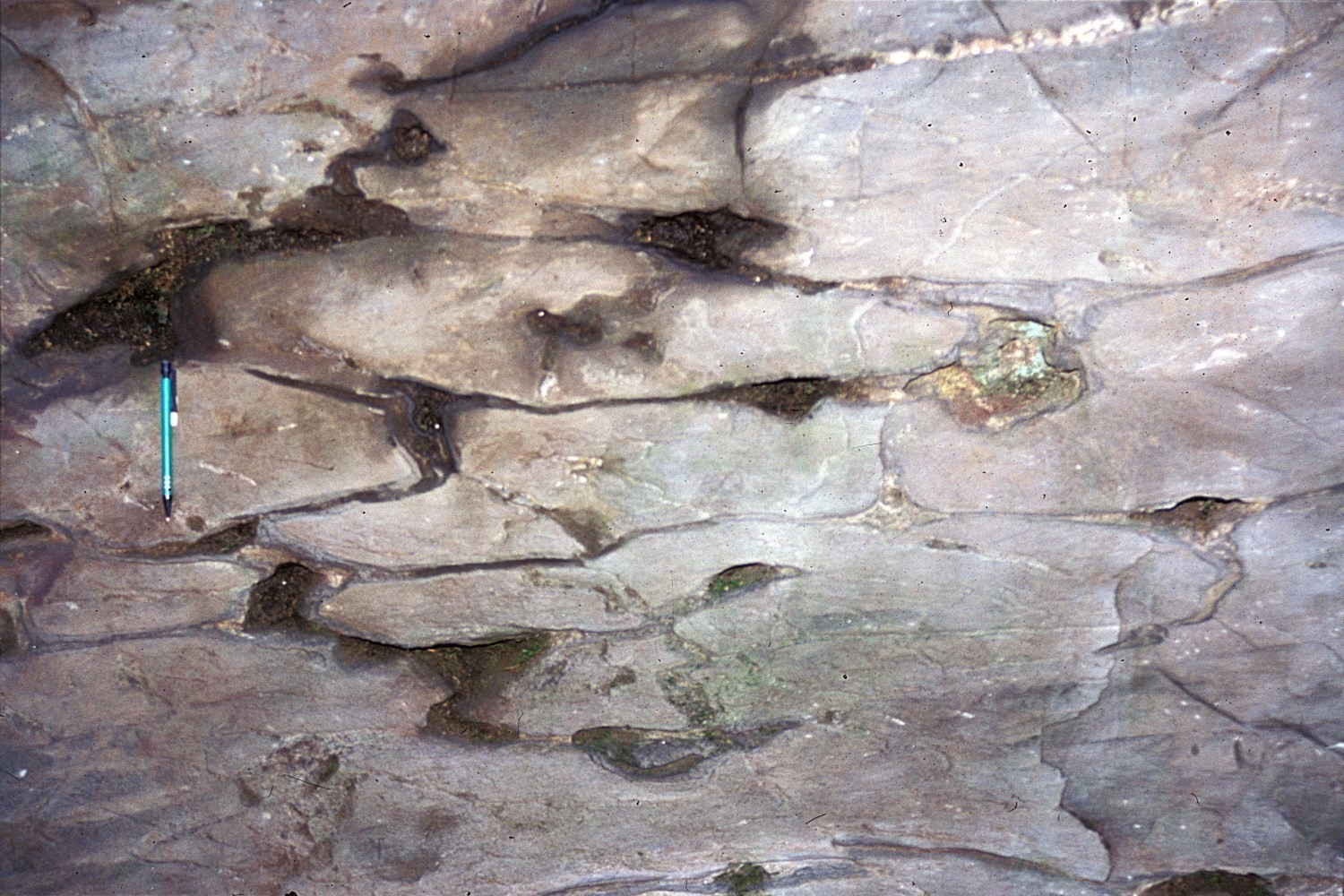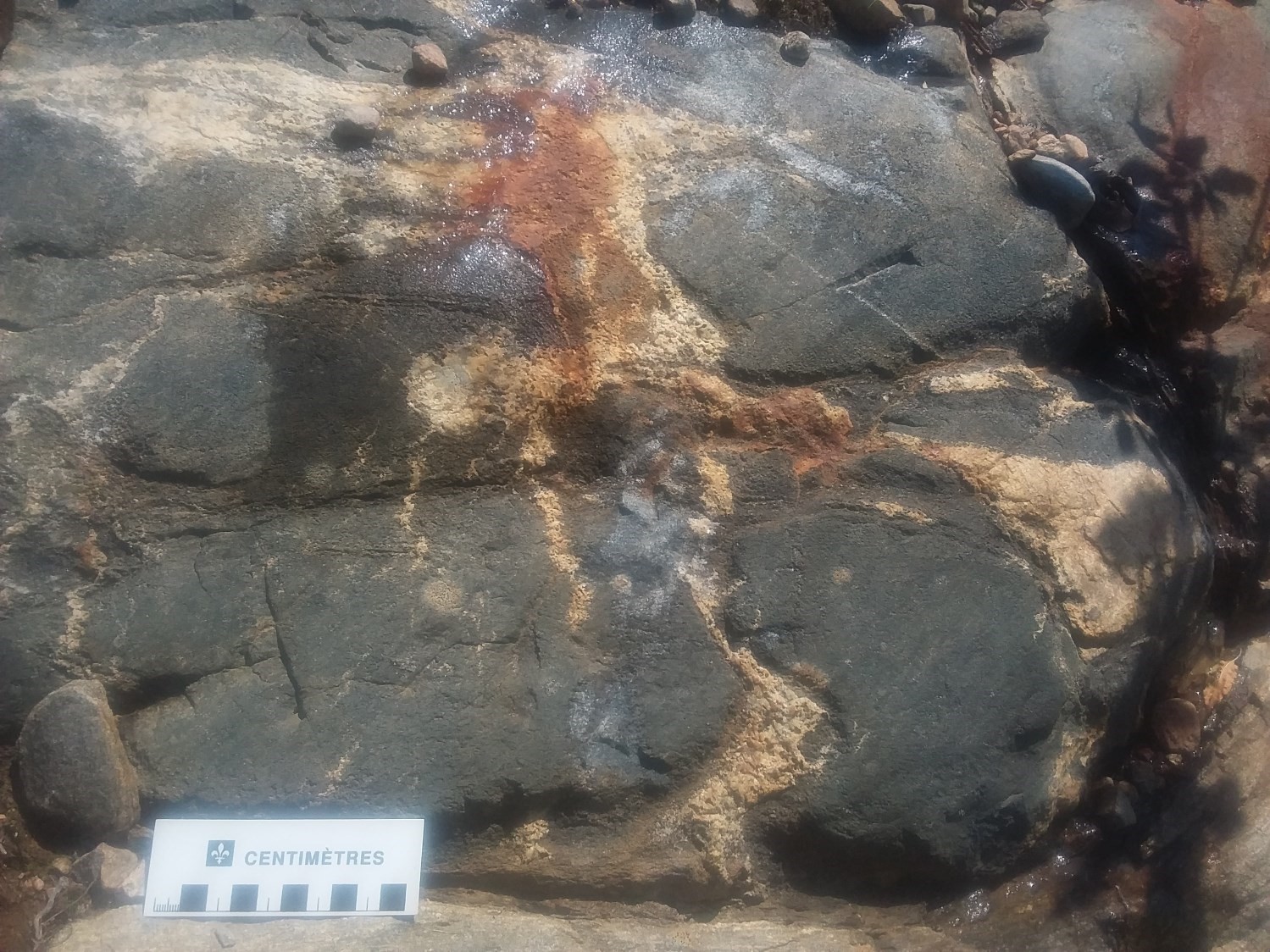
Last modified:
Translation of original French
| Author: | Bancroft, 1916; Rondot, 1978 |
| Age: | Mesoproterozoic |
| Reference section: | |
| Type area: | Haut-Saint-Maurice |
| Geological province: | Grenville Province |
| Geological subdivision: | Allochton |
| Lithology: | Metasedimentary rocks associated with metavolcanic rocks |
| Type: | Lithostratigraphic |
| Rank: | Group |
| Status: | Formal |
| Use: | Active |
None
Background
The Montauban region was first studied by Bancroft (1916). Subsequently, rocks in this area were assigned to the Grenville Series during mapping of the Montauban-les-Mines region (Smith, 1956). The term Montauban Group was introduced by Rondot (1978) to describe rocks that form a metasedimentary series associated with metavolcanic rocks. Pyke (1967) demonstrated the volcanic origin (pillow basalt) of the mafic part of these rocks, based on their geochemistry. A study of Pb-Zn mineralization associated with calcosilicate units and cordierite gneiss was conducted by St. Seymour (1984) to demonstrate that mineralization of the Montauban Mine is of the recrystallized exhalative massive sulphide type. Rondot (1978) separated this group into four units: 1) biotite gneiss; 2) quartzite; 3) amphibolite and metabasalt, and carbonate gneiss; and 4) calcosilicate rocks and cordierite gneiss (Pb-Zn mineralization hosts). Morin (1984, 1985) identified a fifth unit for cordierite-anthophyllite rocks and sillimanite gneiss. During field work, Hébert and Nadeau (1995) revised the five units. A sixth unit was added by Perreault (1992) to describe migmatitized quarztofeldspathic rocks in NTS sheet 31P16. In 2009, Nadeau et al. produced a geological compilation map of the Portneuf-Saint-Maurice region. Only five of the six units were retained, some were modified and the order was reversed. According to Sappin (2012), metavolcanic rocks of the Montauban Group have preserved a complex eruptive history. The proximal facies (lapilli tuff, vesicular basalt, pillow basalt), distal facies (felsic to intermediate volcanic ash), and epiplastic and polymict sedimentary rocks are all connected (Nadeau et al., 1999).
From a geodynamic perspective, metavolcanic rocks of the Montauban Group were deposited in a shallow underwater environment during the final stage of a bimodal volcanism (felsic to mafic) compatible with a mature volcanic arc or a back-arc basin environment (Nadeau et al., 1999). Metamorphosed volcanic rocks and gneiss of the Montauban Group show a geochemical signature (chondrite-normalized rare earth diagram; MORB-normalized spider diagram; TiO2-Zr, Ti-Zr-Y and Nb-Y discrimination diagrams; Zr/Y ratios) compatible with this interpretation (MacLean et al., 1982; Bernier and MacLean, 1993; Gautier, 1993). On the other hand, the predominance of metasedimentary and metavolcanic rocks of intermediate to felsic composition, as well as the scarcity of rocks of highly bimodal composition, points more towards an island arc context than a back-arc basin (Corrigan and van Breemen, 1997).
Description
Rocks of the Montauban Group consist of quartzofeldspathic gneiss, minor amounts of quartzite and scarce horizons of marble and calcosilicate rocks. This metasedimentary package is associated with metavolcanic rocks including pillow metabasalts of tholeiitic affinity, as well as lapilli metatuffs (MacLean et al., 1982; Nadeau et al., 1999).
Montauban Group 1 (mPmt1): Pyritic Paragneiss, Quartzite, Amphibolite, Pegmatite
The pyritic paragneiss facies is fine to medium grained, siliciclastic, rusty and composed of 10 to 25% biotite, muscovite, garnet and sillimanite with some graphite. In this paragneiss, biotite is brownish and is intergrown with fibrous muscovite and sillimanite, giving the rock a lepidoblastic texture. Locally, sillimanite can reach 60% of the rock and is concentrated in centimetre-thick beds. Musovite (≤3%) is observed inside sillimanite and biotite clusters in association with quartz. The latter also follows the orientation of sillimanite and mica. Locally observed, plagioclase forms small crystals and has a mortar texture. The unit contains paragneiss enclaves and some metre-thick quartzite horizons. In places, it is heavily cut by a sillimanite-garnet-muscovite aluminous pegmatite. Locally, pegmatite occurs as metric intrusions, generally conformable and sheared.
Montauban Group 2 (mPmt2): Mesocratic Paragneiss, Locally Migmatitic
This unit consists of fine to medium-grained, grey mesocratic paragneiss, which locally has a banded to migmatitic texture. It also forms horizons in other units of the Montauban Group. Paragneiss is locally banded and contains 10 to 25% mafic minerals such as hornblende and biotite. The rock is fine grained and is characterized by alternating laminas rich in green hornblende, biotite, quartz (undulatory extinction) or plagioclase. Cordierite crystals are observed in several locations. The latter represents a typical assemblage of the high-grade facies, but forms less than 1% of the rock and does not exceed 0.5 mm in size. In addition to sulphides (pyrite), paragneiss also contains sillimanite, zircon, allanite, epidote, titanite and K-feldspar (partially sericitized).
Montauban Group 3 (mPmt3): Metapelite, Amphibolite and Calcosilicate Rock Boudins
This unit consists of garnet porphyroblastic metapetite, fine to medium-grained, light grey and locally banded (centimetre scale). It contains 10 to 25% biotite and garnet with some sillimanite. The rock is foliated and generally migmatitic. Garnet porphyroblasts make up 15% of the rock and are euhedral, reddish and purplish in the presence of sillimanite.
Montauban Group 4 (mPmt4): Quartzite
This unit is less represented in the Borgia Lake area. It consists of quartzite, as well as horizons of amphibolite and tuff belonging to unit mPmt5. Quartzite is impure, light grey and has a granoblastic to holohyaline texture. It contains garnet porphyroblasts (1-2 mm), plagioclase (3 mm) and trace biotite.
Montauban Group 5 (mPmt5): Amphibolite, Lapilli Tuff
This unit consists of volcanic (basalt) granoblastic amphibolite and lapilli tuff. It also forms boudins in other units of the Montauban Group. Amphibolite has a rust-coloured patina associated with traces of iron sulphide. The rock is fine grained, generally homogeneous and locally has strong centimetric banding. The latter is marked by a gradual decrease in the order of 20% of mafic minerals in metric amphibolite horizons. It has a granoblastic texture and contains amphibole, biotite, plagioclase in small polygonal crystals, twinned clinopyroxene (aegerine), trace epidote and, locally, garnet porphyroblasts. Amphibolite is also caraterized by hornblende, hornblende-garnet porphyroblastic and hornblende-clinopyroxene facies. Pillow metabasalts were identified 1 km west of the old Montauban Mine (Pyke, 1967; Bernier, 1992).
Lapilli tuff is intermediate in composition (andesite) and contains calcic plagioclase and clinopyroxene. Some plagioclases are altered and others have rounded edges. Plagioclase is commonly rimmed by biotite and clinopyroxene (<2 mm), forming scattered nodules in the rock. These nodules are separated by small grains of polygonal quartz with undulatory extinction. Several plagioclase crystals contain greyish micro-inclusions, possibly quartz. It could be a filling of microvesicles formed in a volcanoclastic rock. Variable amounts of biotite paragneiss, quartzofeldspathic gneiss and garnetite are associated with this unit. Quartz-plagioclase-biotite felsic to intermediate horizons are also observed. Small biotite crystals are associated with quartz and plagioclase, which are concentrated in millimetric horizons. The whole is oriented parallel to the unit’s planar fabric.
From a geochemical perspective, rocks sampled during the 2017 mapping campaign (Moukhsil and Côté, 2018) have SiO2 contents ranging from 53.92% to 71.05%. The Nesbitt geochemical diagram (2003) suggests that the paragneiss source of units 1, 2 and 5 is granitic to tonalitic. In the same diagram, a few samples mainly located in paragneiss units 1 and 2 approach the muscovite and illite pole, which could reflect an early alteration event. For volcanic rocks, spider diagrams normalized to the primitive mantle and discrimination diagrams of tectonic environment for basalts indicate emplacement in a MORB environment. Rocks sampled in the summer of 2017 correspond to the same tectonic setting environment as those of the Wabash Complex; however, they differ from those sampled in the same unit by MacLean et al. (1982).
Thickness and Distribution
Units of the Montauban Group are best known for their assemblage of metavolcanics, including amphibolitized and pillow basalts of tholeiitic affinity, which have a greater thickness north of the city of Trois-Rivières. To the north of this region, however, these assemblages are more difficult to identify because they are thinner and more dismembered in the surrounding rocks.
Dating
A lapilli tuff was dated 1.45 Ga (Nadeau and van Breemen, 1994).
| Isotopic System | Mineral | Crystallization Age (Ma) | (+) | (-) | Reference(s) |
| U-Pb | Zircon | 1450 | – | – | Nadeau and van Breemen, 1994 |
Stratigraphic Relationship(s)
The Montauban Group is cut by rocks of the La Bostonnais Complex. It also forms dismembered boudins in it and in surrounding intrusive rocks.
Paleontology
Does not apply.
References
| Author(s) | Title | Year of Publication | Hyperlink (EXAMINE or Other) |
|---|---|---|---|
| MOUKHSIL, A. – CÔTÉ, G. | Géologie de la région du lac Borgia, Province de Grenville, nord de La Tuque, régions de la Mauricie et du Saguenay – Lac-Saint-Jean, Québec, Canada. Ministère de l’Énergie et des Ressources naturelles, Québec. | 2018 | Bulletin géologiQUE |
| BANCROFT, J.A. | Rapport sur les gisements de cuivre des Cantons-de-l’Est de la province de Québec. Service des Mines, Ministère de la Colonisation, des Mines et des Pêcheries, Québec; AP 1916-01, 267 pages, 1 map. | 1916 | AP-1916-01 |
| BERNIER, L. R. | Caractérisation géologique, lithogéochimique et pétrologique des gîtes polymétalliques de Montauban et de Dussault. Dans : Séminaire d’information 1992 – Direction de la Recherche géologique. Ministère de l’Énergie et des Ressources naturelles, Québec; DV-92-03, 97 pages. | 1992 | DV-92-03 |
| BERNIER, L. R. – MACLEAN, W. H. | Lithogeochemistry of a metamorphosed VMS alteration at Montauban, Quebec. Canadian institute of mining, metallurgy and Petroleum; volume 2, no. 4, pages 367-386. | 1993 | – |
| CORRIGAN, D. – VAN BREEMEN, O. | U-Pb age constraints for lithotectonic evolution of the Grenville Province along the Mauricie transect, Québec. Canadian Journal of Earth Science; volume 34, pages 299-316. | 1997 | – |
| GAUTHIER, E. | Géochimie et pétrologie du complexe de la Bostonnais et du gabbro du Lac Lapeyrère. Thèse de Maîtrise, Université Laval, Québec. |
1993 | – |
| NADEAU, L. – VAN BREEMEN, O. | Do the 1.45 – 1.39 Ga Montauban Group and the La Bostonnais complex constitute a Grenvillian accreted terrane? In Waterloo ’94. Geological Association of Canada – Mineralogical Association of Canada, Program with Abstracts, 19: A81. | 1994 | – |
| PYKE, D.R. | Geology of the Montauban Area. Ph.D. Thesis, McGill University, Montreal, 274 pages. | 1967 | Source |
| SMITH, J.R. | La région de Montauban-les-Mines. Ministère des Mines, Québec; RG 065, 43 pages. | 1956 | RG 065 |
| RONDOT, J. | Géologie de la Région du Saint-Maurice. Ministère de l’Énergie et des Ressources, Québec; DPV-594, 85 pages. | 1978 | DPV-594 |
| MACLEAN, W. H. – ST-SEYMOUR, K. – PRABHU, M.K. | Lithogeochemistry of a metamorphosed VMS alteration at Montauban, Quebec. Canadian institude of mining, metallurgy and petroleum; volume 2, no. 4, pages 367-386. | 1982 | Source |
| MORIN, G. | Géologie de la région de Montauban. Mémoire de Maîtrise, Université du Québec à Montréal, 142 pages. | 1985 | – |
| MORIN, G. | Métallogénie de la région de Montauban. Ministère de l’Énergie et des Ressources, Québec; ET 83-14, 21 pages, 1 map. | 1984 | ET 83-14 |
| HÉBERT, C. – NADEAU, L. | Géologie de la région de Talbot (Portneuf). Ministère des Ressources naturelles, Commission géologique du Canada; ET 95-01, 16 pages, 1 map. | 1995 | ET 95-01 |
| PERREAULT, S. | Géologie du Grand lac Bostonnais. Ministère des Ressources naturelles et de la Faune, Québec; CG SIGÉOM31P, 1 map. | 1992 | CG SIGEOM31P |
| MACLEAN, W. H. – ST-SEYMOUR, K. – PRABHU, M.K. | Sr, Y, Zr, Ti and REE in Grenville amphibolites at Montauban-les-Mines, Quebec. Canadian Journal of Earth Science; volume 19, pages 633-644. | 1981 | Source |
| NADEAU, L. – BROUILLETTE, P. – HÉBERT, C. | New observations on relict volcanic features in medium-grade gneiss of the Montauban group, Grenville Province, Québec. Geological Survey of Canada, Current Research no. 1999-E, pages 149-160. | 1999 | Source |
| SAPPIN, A.-A. | Pétrologie et métallogénie d’indices de Ni-Cu-éléments du groupe du platine du domaine de Portneuf-Mauricie, Québec (Canada). Thèse de Doctorat, Université Laval, 618 pages. | 2012 | – |
| ST-SEYMOUR, K. – MACLEAN, W.H. | Metamorphosed volcanogenic ores at Montauban, Grenville Province, Quebec. Canadian Mineralogist; volume 22, pages 595-604. | 1984 | – |


